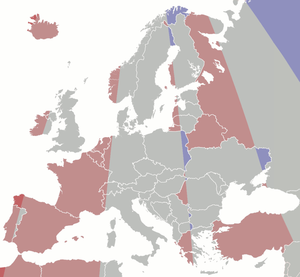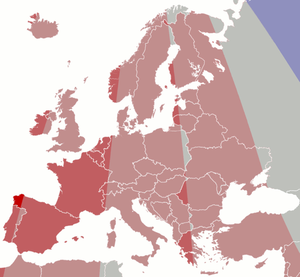Eastern European Time

| Light Blue | Western European Time / Greenwich Mean Time (UTC) |
| Blue | Western European Time / Greenwich Mean Time (UTC) |
| Western European Summer Time / British Summer Time / Irish Standard Time (UTC+1) | |
| Red | Central European Time (UTC+1) |
| Central European Summer Time (UTC+2) | |
| Yellow | Eastern European Time / Kaliningrad Time (UTC+2) |
| Ochre | Eastern European Time (UTC+2) |
| Eastern European Summer Time (UTC+3) | |
| Green | Moscow Time / Turkey Time (UTC+3) |
| Turquoise | Armenia Time / Azerbaijan Time / Georgia Time / Samara Time (UTC+4) |
▉▉▉ Dark colours: Summer time observed
Eastern European Time (EET) is one of the names of UTC+02:00 time zone, 2 hours ahead of Coordinated Universal Time. It is used in some European countries that also use Eastern European Summer Time (EEST; UTC+03:00) as a summer daylight saving time.
Usage
The following countries, parts of countries, and territories use Eastern European Time during the winter only:
- Bulgaria, since 1894
- Cyprus
- Estonia, in years 1921–40 and since 1990
- Finland, since 1921
- Greece, since 1916
- Israel, since 1948
- Jordan
- Latvia, in years 1926–40 and since 1990
- Lebanon
- Lithuania, in 1920–40 and since 1990 with break 1998–1999
- Moldova, in years 1918–40, 1941–44 and since 1991
- Palestinian territories
- Romania
- Syria
- Turkey, since 1910 with break 1978–85
- Ukraine, in years 1922–30 and since 1990[1]
Formerly Eastern European Time has been used in the following areas:
- Moscow used EET in years 1922–30 and 1991–92.
- Kaliningrad Oblast of Russia also used EET in years 1945 and 1991–2011.
- Belarus, in years 1922–30 and 1990–2011[2]
- In Poland this time was used in years 1918–22.
- Egypt, until 2011, and used again 2014
- In time of World War II, Germany implemented MET (CET) in east occupied territories.
Sometimes, due to its use on Microsoft Windows,[3] FLE Standard Time (for Finland, Lithuania, Estonia,[4] sometimes Finland, Latvia, Estonia[5]) or GTB Standard Time (for Greece, Turkey, Bulgaria) are used to refer to Eastern European Time.
Anomalies
Since political, in addition to purely geographical, criteria are used in the drawing of time zones, it follows that actual time zones do not precisely adhere to meridian lines. The EET (UTC+2) time zone, were it drawn by purely geographical terms, would consist of exactly the area between meridians 22°30' E and 37°30' E. As a result, there are European locales that despite lying in an area with a "physical" UTC+2 time, actually use another time zone; contrariwise, there are European areas that have gone for UTC+2, even though their "physical" time zone is different from that. Following is a list of such "incongruencies":
Areas located outside UTC+2 longitudes using Eastern European Time (UTC+2) time
| Colour | Legal time vs local mean time |
|---|---|
| 1 h ± 30 m behind | |
| 0 h ± 30 m | |
| 1 h ± 30 m ahead | |
| 2 h ± 30 m ahead | |
| 3 h ± 30 m ahead |


Areas west of 22°30' E ("physical" UTC+1) that use UTC+2
- The westernmost part of Greece, including the cities of Patras, Ioannina and the island of Corfu
- The very westernmost parts of the Bulgarian provinces of Vidin and Kyustendil
- The westernmost part of Romania, including most of the area of the counties of Caraş-Severin, Timiş (capital Timişoara), Arad, and Bihor, as well as the westernmost tips of the counties of Mehedinţi and Satu Mare
- The extreme westernmost tip of Ukraine, near the border with Hungary and Slovakia, at the Ukrainian Transcarpathian Oblast (Zakarpattia Oblast), essentially comprising the city of Uzhhorod and its environs
- Western Lithuania, including the cities of Klaipėda, Tauragė, and Telšiai
- Western Latvia, including the cities of Liepāja and Ventspils
- The westernmost parts of the Estonian islands of Saaremaa and Hiiumaa, including the capital of the Saare County, Kuressaare
- The southwestern coast of Finland, including the city of Turku; also the Åland islands (of Finnish jurisdiction) – the Åland islands are the westernmost locale applying EET in the whole of Europe
Areas east of 37°30' E ("physical" UTC+3) that use UTC+2
- Eastern Turkey, incl. inter alia the cities of Van (43°37' E), Diyarbakır, Trabzon (Trapezous), and Malatya; practically, it comprises all Turkish territory east of Gaziantep, though this is not geographical Europe. The easternmost city of Turkey is Şemdinli at 44°34' E; that is very close to the 45th meridian, which precisely corresponds to UTC+3. There are two "tri-zone" points involving Turkey:
- The Turkey–Iraq–Iran tripoint in the summer only: Turkey follows UTC+2 with DST, Iraq follows UTC+2 with no DST, and Iran follows UTC+3:30 with DST.
- The Turkey – Azerbaijan (Nakhichevan exclave) – Iran tripoint: Turkey follows UTC+2 with DST, Azerbaijan follows UTC+4 with DST, and Iran follows UTC+3:30 with DST.
- The easternmost part of Ukraine, incl. the cities of Luhansk, Donetsk, and Mariupol. The town of Milove, Luhansk Oblast, on the Ukrainian-Russian border, is the easternmost city in geographical Europe that applies UTC+2 (if political Europe, which includes the Anatolian part of Turkey, is to be considered, then that title goes to Şemdinli; see above)
Areas located within UTC+2 longitudes (22°30' E – 37°30' E) using other time zones
Areas that use UTC+1
These areas have sunrises and sunsets at least half an hour earlier than places on the UTC+1 meridian.
- The easternmost part of the Republic of Macedonia, including the city of Strumica.
- The absolutely easternmost part of Serbia, in the Pirot District, including the city of Pirot.
- The extreme easternmost tips of Hungary and Slovakia, bordering to the north and south respectively the Ukrainian Transcarpathian Oblast (Zakarpattia Oblast), a bit to the east of the Vásárosnamény, Hungary – Uzhhorod, Ukraine (both at 22°18' E) line
- The easternmost part of Poland, including the cities of Lublin and Białystok
- The extreme northeast of Sweden, in the Norrbotten province, including the cities of Kalix and Haparanda
- The northeast of Norway, lying north of Finland, roughly coinciding with the county of Finnmark. Actually, the easternmost town in Norway, Vardø, lies at 30°51' E, which is so far east, so as to be east even of the central meridian of EET (UTC+2), i.e. east of Istanbul and Alexandria. The Norwegian-Russian border (incl. border passings such as Kirkenes) is the only place where CET (UTC+1/+2) borders Moscow time (UTC+4), resulting in a two (2) (or three in winter) hour time change for the passenger crossing that border. More so, there exists a "tri-zone" point (where UTC+1, UTC+2, and UTC+4 meet) at the Norway-Finland-Russia tripoint (look for the town of Nautsi in this map). Actually, it is interesting to perform the following mental experiment when looking at this map: Go to the westernmost point of the red area (the Jäniskoski-Niskakoski area); this belongs to Russian jurisdiction, hence the time there is UTC+4. Then, take a northeastern (NE) direction (that is an eastwards direction); you will soon be crossing into Finnish territory, thus moving to the UTC+2 time zone. Continuing in that direction, you will eventually reach the Finland-Norway border and enter Norway, thus passing into the UTC+1 time zone. So, moving in a (north-)easterly direction, you will actually be moving from UTC+4 to UTC+2 to UTC+1! A note for time zone tourists: It is illegal to cross the Russian border outside a border control.
Areas that use UTC+3
- Belarus is located between 23°11′E and 32°47′E and is thus fully located with the physical UTC+2 area, but it uses UTC+3 year around.
Areas that use UTC+4
- Practically all European Russia west of Moscow; This includes the chunk of land from Murmansk all the way south to Belgorod, including the cities of St. Petersburg, Novgorod, and Pskov, to name only a few. (The westernmost point of contiguous Russia, near Lavry, Pskov Oblast, 27°19' E, is actually the westernmost point in Europe where UTC+4 is applied.) To the above should be added the city of Anapa, at the westernmost tip of the Krasnodar Krai near the entrance to the Sea of Azov, at 37°22' E
Tripoints and borders between zones
- The Norway–Russia–Finland "tri-zone" point at Muotkavaara (see Central European Time) is the only year-around "tri-zone" in Europe.
- All four two tripoints of Belarus and the tripoint of the Kaliningrad Region are surrounded by three different times in winter.
- The short (9 km or 6 mi) only Turkey–Azerbaijan (Nakhichevan exclave) border exhibits the same property as the Norway–Russia one, in that by travelling from west (Turkey) to east (Azerbaijan) one moves forward not one, but two time zones (UTC+2 to UTC+4)
Major metropolitan areas
- Adana, Turkey
- Aleppo, Syria
- Alexandria, Egypt
- Amman, Jordan
- Ankara, Turkey
- Antalya, Turkey
- Athens, Greece
- Beirut, Lebanon
- Brașov, Romania
- Bucharest, Romania
- Bursa, Turkey
- Cairo, Egypt
- Chişinău, Moldova
- Cluj-Napoca, Romania
- Constanța, Romania
- Damascus, Syria
- Daugavpils,Latvia
- Gaza
- Helsinki, Finland
- Iaşi, Romania
- İstanbul, Turkey
- İzmir, Turkey
- Jerusalem, Israel
- Kyiv, Ukraine
- Nicosia, Cyprus
- Riga, Latvia
- Sofia, Bulgaria
- Tallinn, Estonia
- Tel Aviv, Israel
- Thessaloniki, Greece
- Timişoara, Romania
- Vilnius, Lithuania
References
- ^ Ukraine to return to standard time on Oct. 30 (updated)
- ^ Eternal Daylight Saving Time (DST) in Belarus
- ^ http://technet.microsoft.com/en-us/library/cc749073%28v=ws.10%29.aspx
- ^ http://acronyms.thefreedictionary.com/Foreign+Legal+Entity
- ^ http://acronyms.thefreedictionary.com/Finland+Latvia+Estonia+Time
